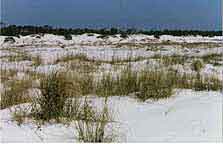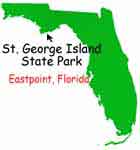
Reservations for
Florida State
Parks are now
made through
Reserve America,
toll free, at
1-800-326-3521

PET
FRIENDLY
PARK
see
policy
|
ST.
GEORGE ISLAND STATE PARK

photos courtesy
of The Creative Source, Palm Bay, FL |
Nine miles of undeveloped beaches and dunes, surrounded by the Gulf of Mexico
and Apalachicola Bay, provide the perfect setting for St. George Island
State Park. Occupying 1,962 acres at the end of a long, narrow barrier island,
St. George is a combination of sandy coves, salt marshes, shady pines and
oak forests.
HISTORY
During most of its 5,000 years of existence, St. George Island was uninhabited
by man. During the early and middle 1900s, the island's pine forests were
turpentined. Many scars are still visible on the island's larger slash pines.
During World War II, the island was used by troops for numerous training
exercises that were carried out over the area's vast dunes. Acquisition
of land for the park in 1963 and completion of the causeway in 1965 led
to increased use of the beaches for recreational activity. In 1980, construction
of the park facilities was complete, and the park was opened for public
use.
GEOGRAPHY
The natural features of the park include extensive beaches and dunes, forests
of slash pines and live oak hammocks. The ocean and bay support an abundance
of marine life, while small freshwater ponds and sloughs provide a limited
aquatic habitat in an otherwise arid climate. The waters of this area are
some of the most productive commercial and sport fisheries in Florida, with
a thriving oyster industry at the mouth of the Apalachicola River.
WILDLIFE
The arid conditions, coupled with the park's island location, limit both
the number and type of resident animal life. Osprey may frequently be seen
fishing in the waters, and their nests are found in the tops of living or
dead pine trees in the park. Raccoons and ghost crabs may be observed, along
with the salt-marsh snakes and diamondback terrapin that reside in the marsh
and bay waters. Birds such as the snowy plover, least
tern, black skimmer, willet and many other species of shorebirds frequently
nest along the park's sandy shores and grass flats. The barrier islands
of the Gulf Coast are important "rest stops" for a wide variety
of migrating birds during the fall and spring. The best time to observe
migrating birds is after the passage of cold fronts.
REAL FUN IN THE REAL FLORIDA
Recreation facilities include a series of hiking trails, boardwalks and
observation platforms.
Camping is permitted in the
campground located in the pine forests on the bay side or in the primitive
campsites at Gap Point for those who wish to hike the 2.5-mile trail.
The trail to Gap Point begins
in the campground and meanders through the pine flatwood forest to the
bay.
Swimming and sunbathing are
popular activities on the white sandy beaches and clear Gulf waters. NO
LIFEGUARDS ARE PROVIDED.
Surf and bay fishing may yield
catches of flounder, redfish, sea trout, pompano, whiting or sometimes
Spanish mackerel. A saltwater fishing license is required in Florida.
Boat ramps are located at the
Youth Camp Area and East Slough.
The speed limit on the park drive
is 25 mph, except as posted. No vehicles of any type are permitted in the
dune areas.

St. George Island is located on St. George Island, 10 miles southeast of Eastpoint, off U.S. 98.
For more information, contact:
St. George Island State Park
1900 E. Gulf Beach Dr.
St. George Island, Florida
32328
850/927-2111.
View Larger Map
|
|



